Satas D., Tracton A.A. (ed.). Coatings Technology Handbook
Подождите немного. Документ загружается.

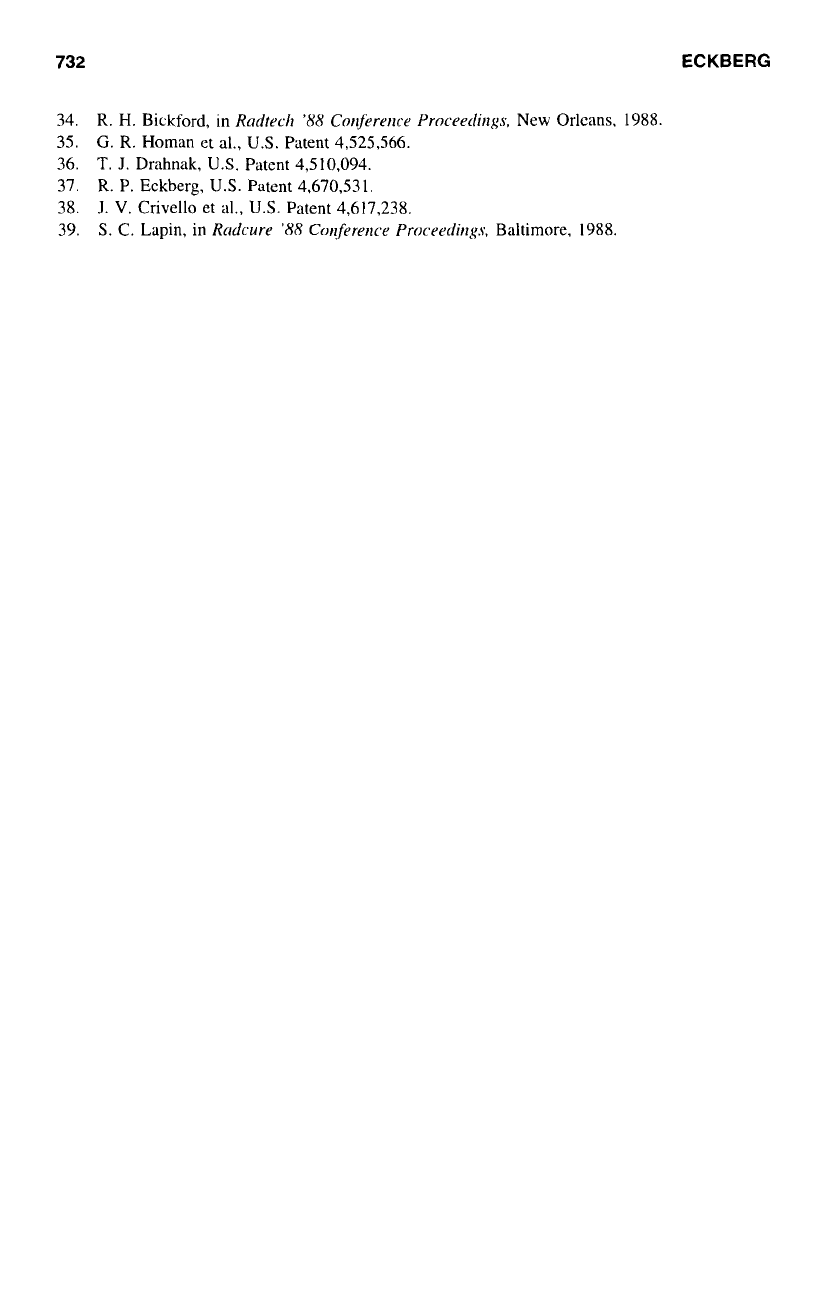
732
ECKBERG
34.
R.
H.
Bickford,
in
Radtrch
'88
Cortjererlce Proceedings,
New
Orleans, 1988.
35. G.
R.
Homan
et
al.,
US.
Patent 4,525,566.
36.
T.
J.
Drahnak,
U.S.
Patent 4,510,094.
37.
R.
P. Eckberg,
U.S.
Patent 4,670,531.
38.
J.
V.
Crivello
et
al.,
U.S.
Patent 4,617,238.
39.
S.
C. Lapin,
in
Rrrdcurr
'88
Corfrrencr Proceedirlgs.
Baltimore. 1988.
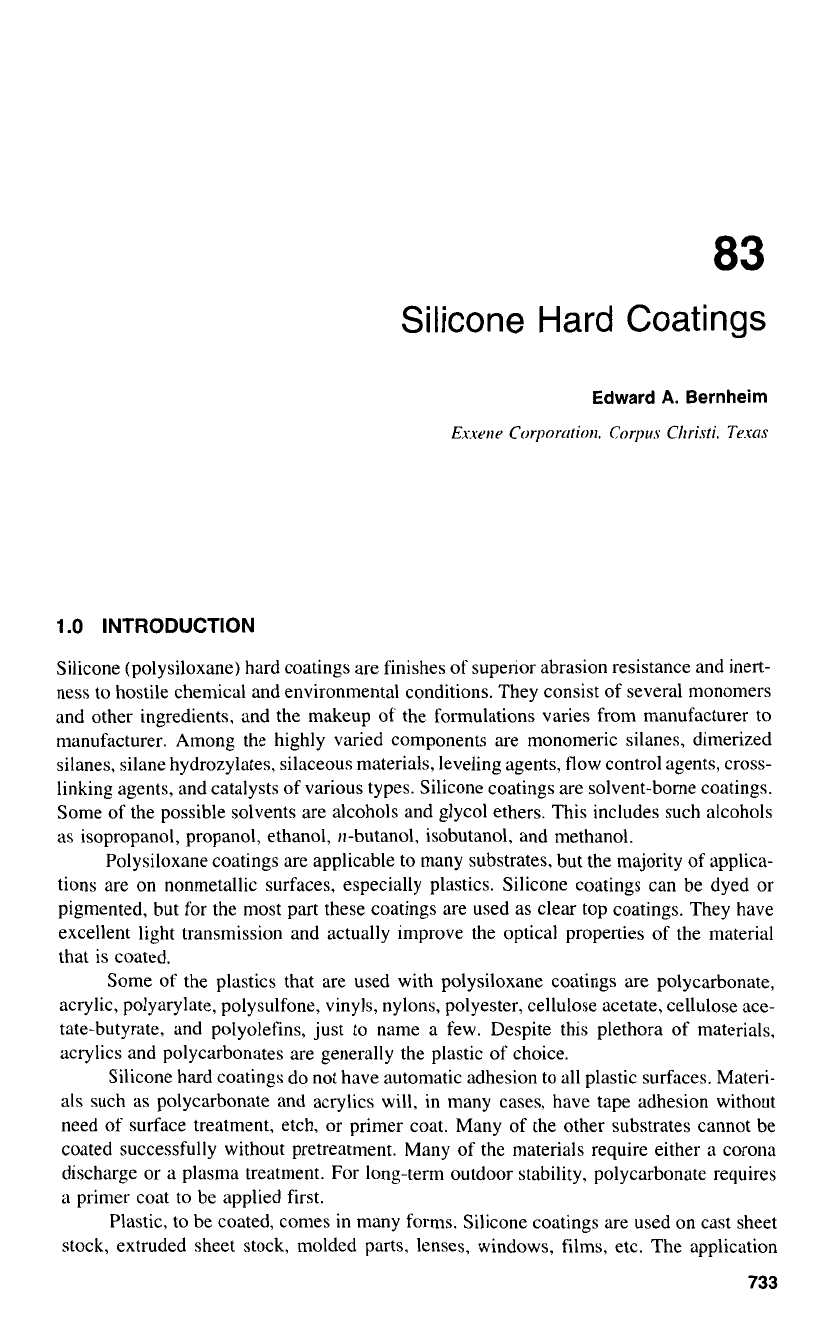
83
Silicone Hard Coatings
1
.O
INTRODUCTION
Silicone (polysiloxane) hard coatings are finishes of superior abrasion resistance and inert-
ness to hostile chemical and environmental conditions. They consist
of
several monomers
and other ingredients, and the makeup of the formulations varies from manufacturer to
manufacturer. Among the highly varied components are monomeric silanes, dimerized
silanes, silane hydrozylates, silaceous materials, leveling agents, flow control agents, cross-
linking agents, and catalysts
of
various types. Silicone coatings are solvent-borne coatings.
Some
of
the possible solvents are alcohols and glycol ethers. This includes such alcohols
as isopropanol, propanol, ethanol, 11-butanol, isobutanol, and methanol.
Polysiloxane coatings are applicable
to
many substrates, but the majority
of
applica-
tions are on nonmetallic surfaces, especially plastics. Silicone coatings can be dyed or
pigmented, but for the most part these coatings are used as clear top coatings. They have
excellent light transmission and actually improve the optical properties of the material
that is coated.
Some of the plastics that are used with polysiloxane coatings are polycarbonate,
acrylic, polyarylate, polysulfone, vinyls, nylons, polyester, cellulose acetate, cellulose ace-
tate-butyrate, and polyolefins, just to name a few. Despite this plethora of materials,
acrylics and polycarbonates are generally the plastic of choice.
Silicone hard coatings do not have automatic adhesion to all plastic surfaces. Materi-
als such as polycarbonate and acrylics will, in many cases. have tape adhesion without
need
of
surface treatment, etch, or primer coat. Many of the other substrates cannot be
coated successfully without pretreatment. Many of the materials require either a corona
discharge or a plasma treatment. For long-term outdoor stability, polycarbonate requires
a
primer coat to be applied first.
Plastic, to be coated, comes in many forms. Silicone coatings are used on cast sheet
stock, extruded sheet stock, molded parts. lenses, windows, films, etc. The application
733
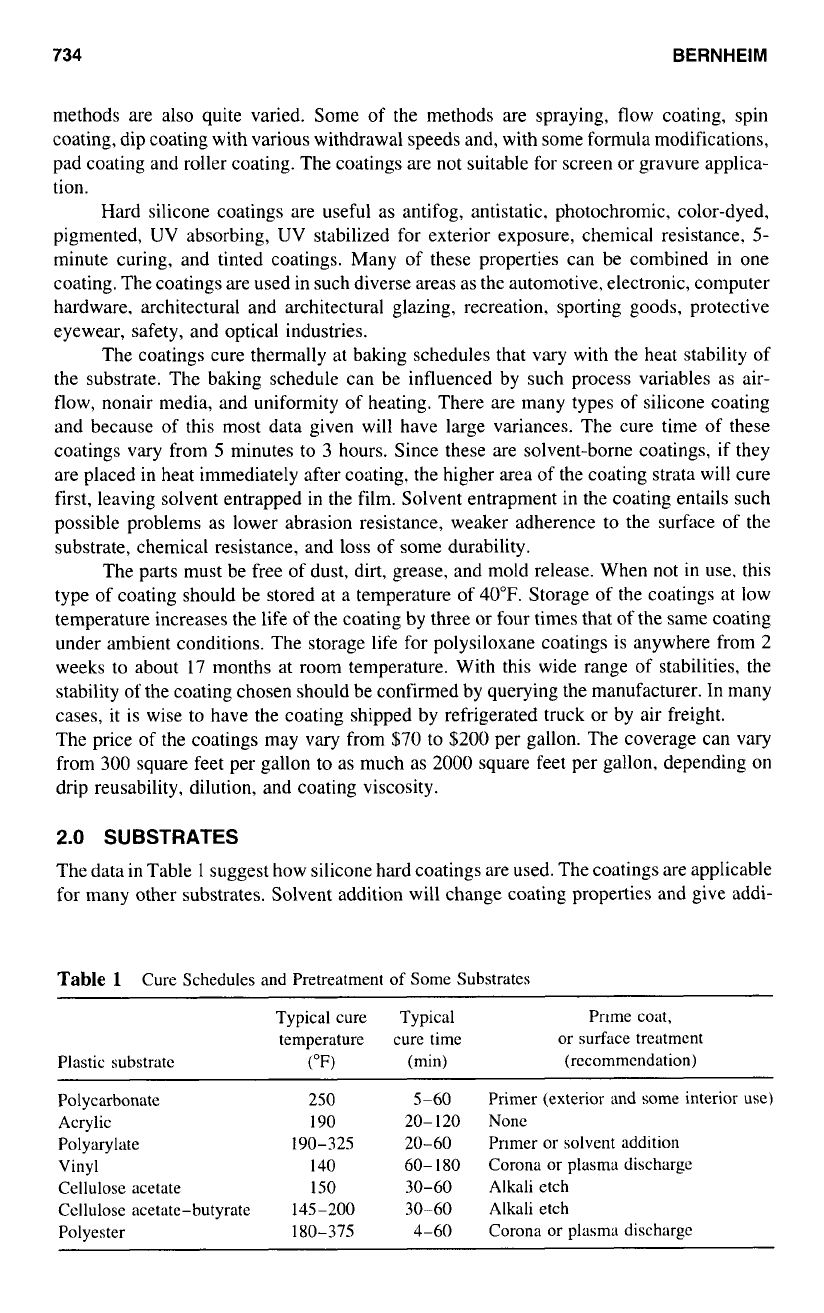
734
BERNHEIM
methods are also quite varied. Some of the methods are spraying, flow coating, spin
coating, dip coating with various withdrawal speeds and, with some formula modifications,
pad coating and roller coating. The coatings are not suitable for screen or gravure applica-
tion.
Hard silicone coatings are useful
as
antifog, antistatic, photochromic, color-dyed,
pigmented,
UV
absorbing,
UV
stabilized for exterior exposure, chemical resistance.
5-
minute curing, and tinted coatings. Many of these properties can be combined in one
coating. The coatings are used in such diverse areas as the automotive, electronic, computer
hardware. architectural and architectural glazing, recreation, sporting goods, protective
eyewear, safety, and optical industries.
The coatings cure thermally at baking schedules that vary with the heat stability of
the substrate. The baking schedule can be influenced by such process variables as air-
flow, nonair media, and uniformity of heating. There are many types of silicone coating
and because
of
this most data given will have large variances. The cure time
of
these
coatings
vary
from
5
minutes to 3 hours. Since these are solvent-borne coatings,
if
they
are placed in heat immediately after coating, the higher area
of
the coating strata will cure
first, leaving solvent entrapped in the film. Solvent entrapment in the coating entails such
possible problems
as
lower abrasion resistance, weaker adherence to the surface of the
substrate, chemical resistance, and loss of some durability.
The parts must be free of dust, dirt, grease, and mold release. When not in use, this
type of coating should be stored at a temperature of 40°F. Storage of the coatings at low
temperature increases the life
of
the coating by three or four times that of the same coating
under ambient conditions. The storage life for polysiloxane coatings is anywhere from 2
weeks to about
17
months at room temperature. With this wide range of stabilities, the
stability of the coating chosen should be confirmed by querying the manufacturer. In many
cases, it is wise to have the coating shipped by refrigerated truck or by air freight.
The price
of
the coatings may vary from $70 to $200 per gallon. The coverage can vary
from 300 square feet per gallon to
as
much
as
2000 square feet per gallon. depending
on
drip reusability, dilution, and coating viscosity.
2.0
SUBSTRATES
The data in Table
1
suggest how silicone hard coatings are used. The coatings are applicable
for many other substrates. Solvent addition will change coating properties and give addi-
Table
1
Cure Schedules and Pretreatment
of
Some Substrates
Typical
cure
Typical
Prlme coat,
temperature
cure time
or
surface treatmcnt
Plastic substrate
("F)
(min) (rccommcndation)
Polycarbonate
250
S-60
Primer (exterior and some interior
use)
Acrylic
190
20- I20
None
Polyarylate
190-325
20-60
Prlmer
or
solvent addition
Vinyl
I40
60-
I80
Corona
or
plasma discharge
Cellulose acetate
150
30-60
Alkali etch
Cellulose acetate-butyrate
145-200
30-60
Alkali etch
Polyester
180-37s
4-60
Corona
or
plasma discharge
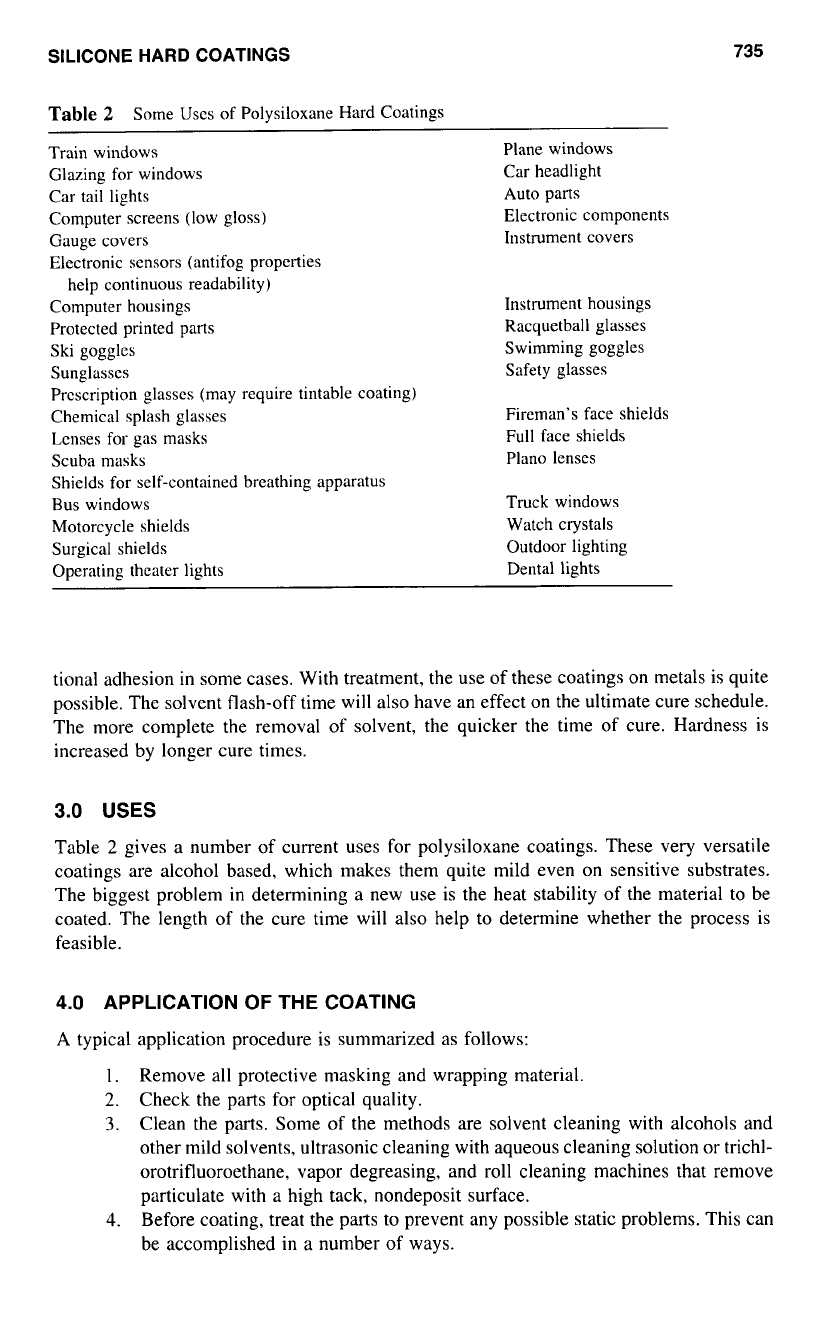
SILICONE HARD COATINGS
735
Table
2
Some
Uses
of Polysiloxane Hard Coatings
Train windows Plane windows
Glazing for windows Car headlight
Car tail lights Auto
parts
Computer screens (low gloss) Electronic components
Gauge covers Instrument covers
Electronic sensors (antifog properties
Computer housings Instrument housings
Protected printed parts Racquetball glasses
Ski gogglcs Swimming goggles
Sunglasses Safety glasses
Prescription glasses (may require tintable coating)
Chemical splash glasses Fireman’s face shields
Lcnses
for gas masks Full face shields
Scuba masks Plano lenses
Shields for self-contained breathing apparatus
Bus windows Truck windows
Motorcycle shields Watch crystals
Surgical shields Outdoor lighting
Operating theater lights Dental lights
help continuous readability)
tional adhesion
in
some cases. With treatment, the use of these coatings on metals is quite
possible. The solvent flash-off time will
also
have an effect on the ultimate cure schedule.
The more complete the removal
of
solvent, the quicker the time of cure. Hardness is
increased by longer cure times.
3.0
USES
Table
2
gives
a
number
of
current uses for polysiloxane coatings. These very versatile
coatings are alcohol based, which makes them quite mild even on sensitive substrates.
The biggest problem in determining
a
new use is the heat stability of the material to be
coated. The length
of
the cure time will
also
help to determine whether the process is
feasible.
4.0
APPLICATION OF THE COATING
A
typical application procedure is summarized
as
follows:
1.
Remove
all
protective masking and wrapping material.
2.
Check the parts for optical quality.
3.
Clean the parts. Some
of
the methods are solvent cleaning with alcohols and
other mild solvents, ultrasonic cleaning with aqueous cleaning solution or trichl-
orotrifluoroethane, vapor degreasing, and roll cleaning machines that remove
particulate with
a
high tack, nondeposit surface.
4.
Before coating, treat the parts to prevent any possible static problems. This can
be accomplished in
a
number
of
ways.
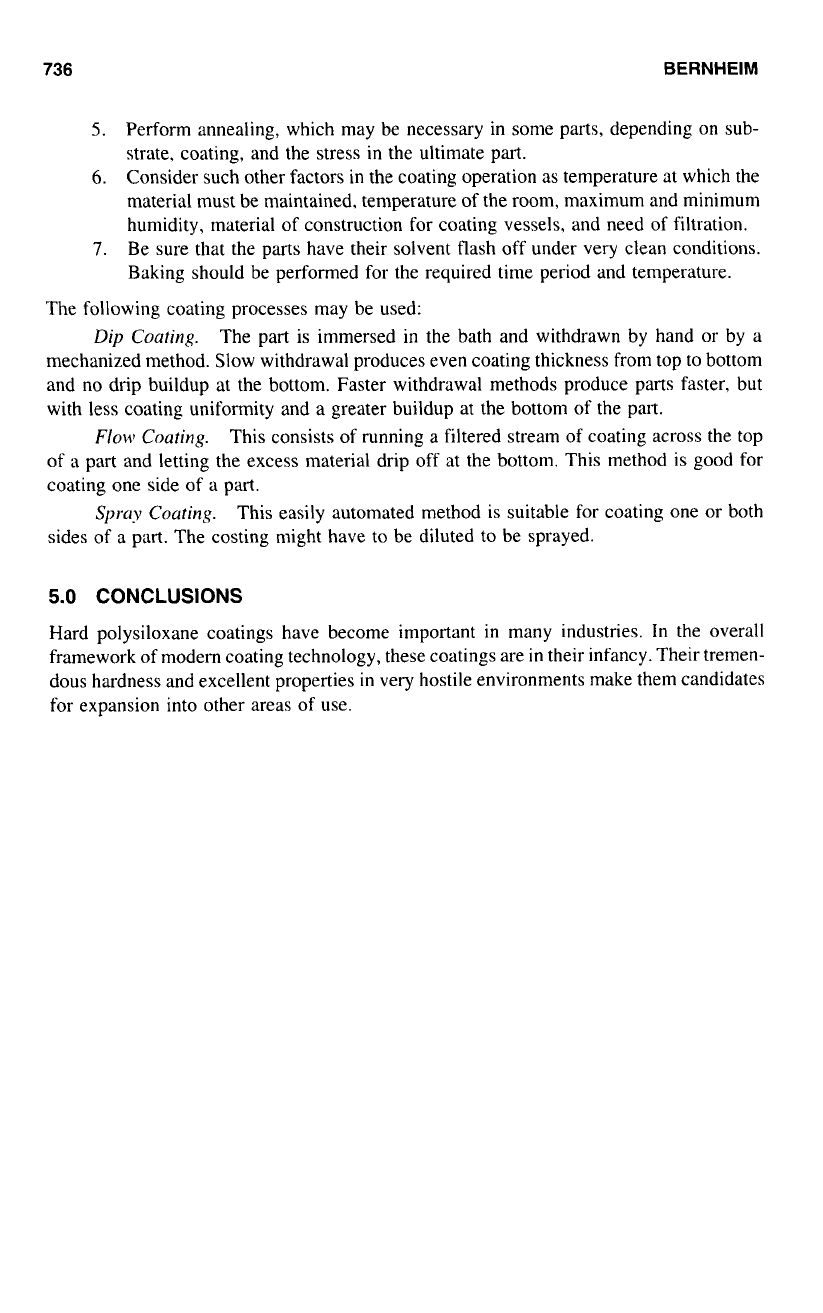
736
BERNHEIM
5.
Perform annealing, which may be necessary
in
some parts, depending on sub-
strate, coating, and the stress in the ultimate part.
6.
Consider such other factors in the coating operation as temperature at which the
material must be maintained, temperature of the room, maximum and minimum
humidity, material
of
construction for coating vessels, and need of filtration.
7.
Be sure that the parts have their solvent flash off under very clean conditions.
Baking should be performed for the required time period and temperature.
The following coating processes may be used:
Dip Coating.
The part is immersed
in
the bath and withdrawn by hand or by
a
mechanized method. Slow withdrawal produces even coating thickness from top to bottom
and no drip buildup at the bottom. Faster withdrawal methods produce parts faster, but
with less coating uniformity and a greater buildup at the bottom
of
the part.
Flow
Coating.
This consists of running
a
filtered stream of coating across the top
of
a
part and letting the excess material drip off at the bottom. This method is good for
coating one side of
a
part.
Spray
Coating.
This easily automated method
is
suitable for coating one or both
sides of
a
part. The costing might have to be diluted to be sprayed.
5.0
CONCLUSIONS
Hard polysiloxane coatings have become important
in
many industries. In the overall
framework
of
modern coating technology, these coatings are
in
their infancy. Their tremen-
dous hardness and excellent properties
in
very hostile environments make them candidates
for expansion into other areas
of
use.
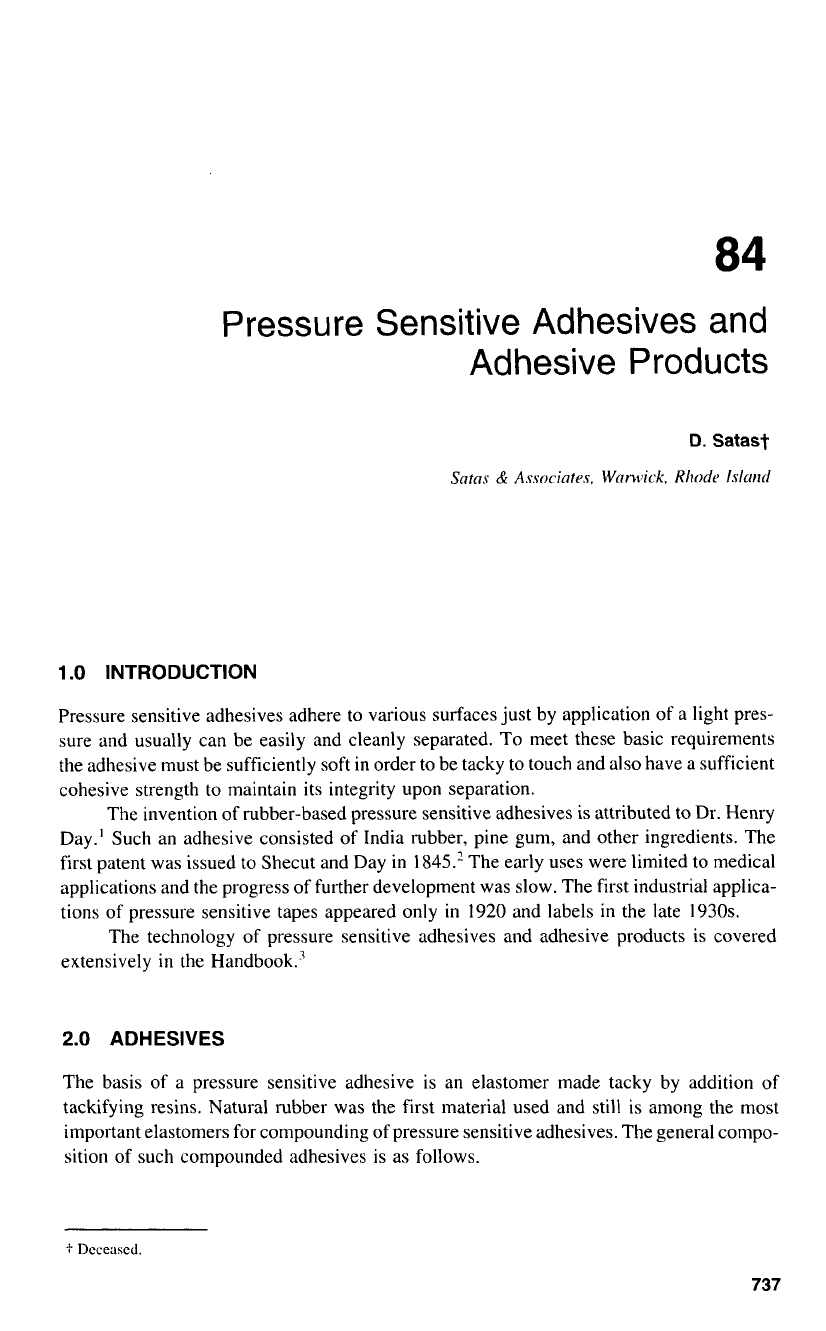
Pressure Sensitive Adhesives and
Adhesive Products
1
.O
INTRODUCTION
Pressure sensitive adhesives adhere to various surfaces just by application of a light pres-
sure and usually can be easily and cleanly separated. To meet these basic requirements
the adhesive must be sufficiently soft in order to be tacky to touch and
also
have a sufficient
cohesive strength
to
maintain its integrity upon separation.
The invention
of
rubber-based pressure sensitive adhesives is attributed to Dr. Henry
Day.' Such an adhesive consisted
of
India rubber, pine gum, and other ingredients. The
first patent was issued to Shecut and Day in
1845.'
The early uses were limited to medical
applications and the progress
of
further development was slow. The first industrial applica-
tions of pressure sensitive tapes appeared only
in
1920
and labels in the late
1930s.
The technology of pressure sensitive adhesives and adhesive products is covered
extensively in the Handbook?
2.0
ADHESIVES
The basis of
a
pressure sensitive adhesive is an elastomer made tacky by addition
of
tackifying resins. Natural rubber was the first material used and still is among the most
important elastomers for compounding of pressure sensitive adhesives. The general compo-
sition
of
such compounded adhesives
is
as
follows.
t
Deceased.
737
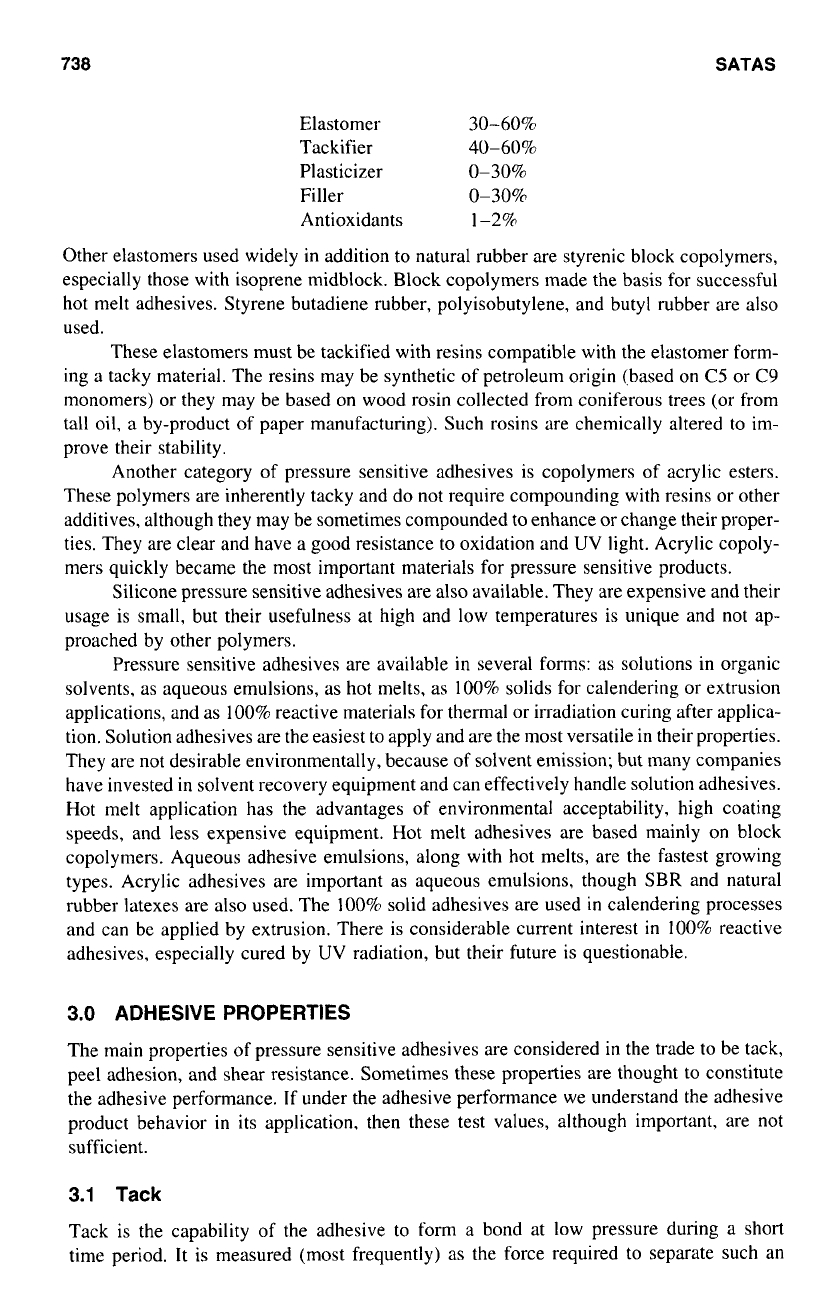
738
SATAS
Elastomer 30-60%
Tackifier 40-60%
Plasticizer 0-30%
Filler
0-30%
Antioxidants
1-296
Other elastomers used widely in addition to natural rubber are styrenic block copolymers,
especially those with isoprene midblock. Block copolymers made the basis for successful
hot melt adhesives. Styrene butadiene rubber, polyisobutylene, and butyl rubber are also
used.
These elastomers must be tackified with resins compatible with the elastomer form-
ing a tacky material. The resins may be synthetic
of
petroleum origin (based on
C5
or
C9
monomers) or they may be based on wood rosin collected from coniferous trees (or from
tall oil. a by-product of paper manufacturing). Such rosins are chemically altered to im-
prove their stability.
Another category of pressure sensitive adhesives is copolymers of acrylic esters.
These polymers are inherently tacky and do not require compounding with resins or other
additives, although they may be sometimes compounded to enhance or change their proper-
ties. They are clear and have a good resistance
to
oxidation and
UV
light. Acrylic copoly-
mers quickly became the most important materials for pressure sensitive products.
Silicone pressure sensitive adhesives are also available. They are expensive and their
usage is small, but their usefulness at high and low temperatures is unique and not ap-
proached by other polymers.
Pressure sensitive adhesives are available in several forms:
as
solutions in organic
solvents, as aqueous emulsions, as hot melts, as
100%
solids for calendering or extrusion
applications, and as
100%
reactive materials for thermal or irradiation curing after applica-
tion. Solution adhesives are the easiest to apply and are the most versatile
in
their properties.
They are not desirable environmentally, because
of
solvent emission; but many companies
have invested in solvent recovery equipment and can effectively handle solution adhesives.
Hot melt application has the advantages of environmental acceptability, high coating
speeds, and less expensive equipment. Hot melt adhesives are based mainly on block
copolymers. Aqueous adhesive emulsions, along with hot melts, are the fastest growing
types. Acrylic adhesives are important as aqueous emulsions, though
SBR
and natural
rubber latexes are also used. The
100%
solid adhesives are used
in
calendering processes
and can be applied by extrusion. There is considerable current interest
in
100%
reactive
adhesives, especially cured by
UV
radiation, but their future is questionable.
3.0
ADHESIVE
PROPERTIES
The main properties
of
pressure sensitive adhesives are considered in the trade
to
be tack,
peel adhesion, and shear resistance. Sometimes these properties are thought to constitute
the adhesive performance. If under the adhesive performance we understand the adhesive
product behavior in its application, then these test values, although important, are
not
sufficient.
3.1
Tack
Tack is the capability of the adhesive to form a bond at low pressure during
a
short
time period. It is measured (most frequently) as the force required to separate such an
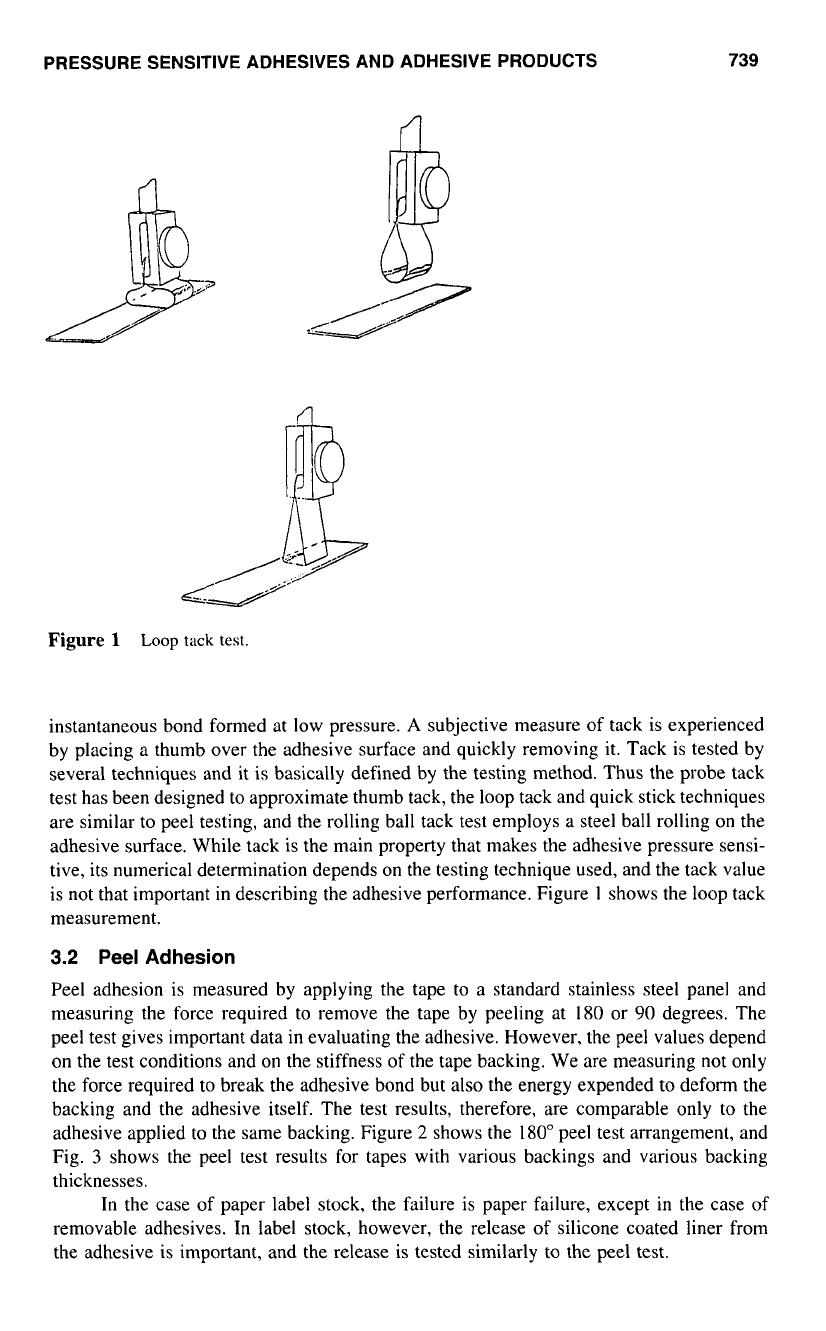
PRESSURE SENSITIVE ADHESIVES AND ADHESIVE PRODUCTS
739
Figure
1
Loop
tack
test.
instantaneous bond formed at low pressure.
A
subjective measure
of
tack is experienced
by placing a thumb over the adhesive surface and quickly removing it. Tack is tested by
several techniques and it is basically defined by the testing method. Thus the probe tack
test has been designed to approximate thumb tack, the loop tack and quick stick techniques
are similar to peel testing, and the rolling ball tack test employs
a
steel ball rolling on the
adhesive surface. While tack is the main property that makes the adhesive pressure sensi-
tive, its numerical determination depends on the testing technique used, and the tack value
is not that important in describing the adhesive performance. Figure
1
shows the loop tack
measurement.
3.2
Peel Adhesion
Peel adhesion
is
measured by applying the tape to
a
standard stainless steel panel and
measuring the force required to remove the tape by peeling at
180
or
90
degrees. The
peel test gives important data in evaluating the adhesive. However, the peel values depend
on
the test conditions and
on
the stiffness of the tape backing. We are measuring not only
the force required to break the adhesive bond but
also
the energy expended to deform the
backing and the adhesive itself. The test results, therefore, are comparable only
to
the
adhesive applied
to
the same backing. Figure
2
shows the
180"
peel test arrangement, and
Fig.
3
shows the peel test results for tapes with various backings and various backing
thicknesses.
In the case of paper label stock, the failure is paper failure, except in the case
of
removable adhesives. In label stock, however, the release of silicone coated liner from
the adhesive is important, and the release is tested similarly to the peel test.
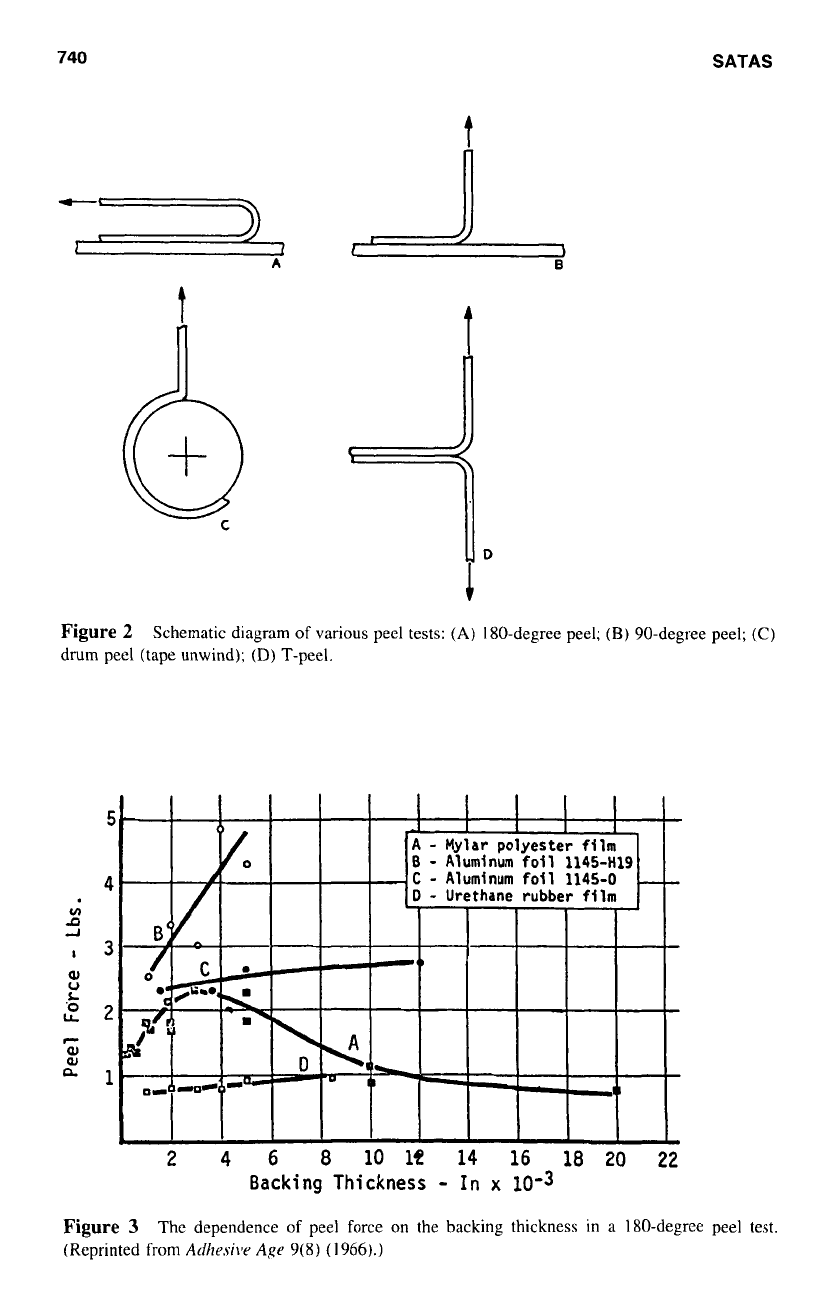
740
SATAS
t
Figure
2
Schematic diagram
of
various
peel
tests:
(A)
180-degree peel;
(B)
90-degree peel;
(C)
drum peel (tape unwind);
(D)
T-peel.
2
4
6
8
10
le
14
16
18
20
22
Backing
Thickness
-
In
x
10-3
Figure
3
The dependence
of
peel force on the backing thickness
in
a
180-degree peel test.
(Reprinted
from
Adlwsiw
Age
9(8)
(I
966).)
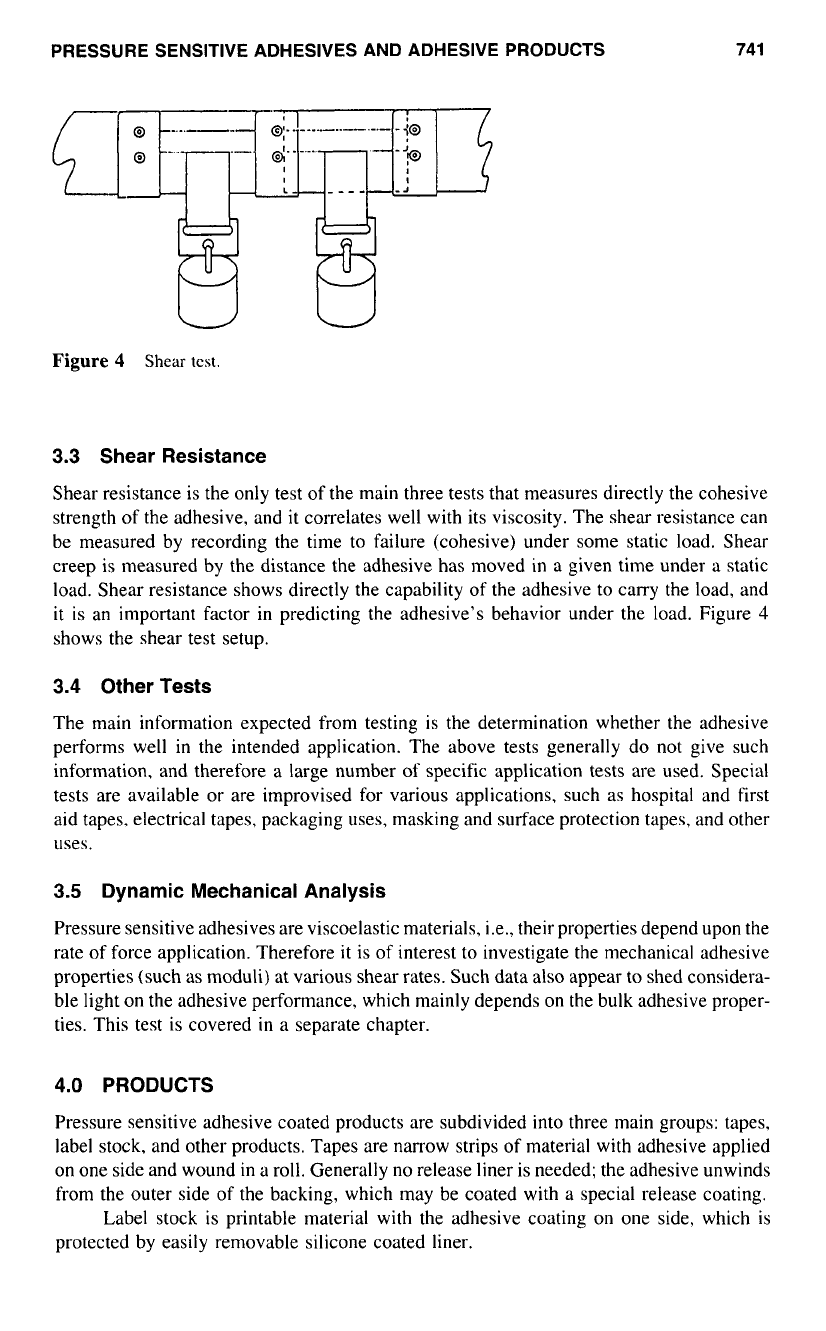
PRESSURE SENSITIVE ADHESIVES AND ADHESIVE PRODUCTS
741
Figure
4
Shear
test.
3.3 Shear Resistance
Shear resistance is the only test of the main three tests that measures directly the cohesive
strength of the adhesive, and it correlates well with its viscosity. The shear resistance can
be measured by recording the time to failure (cohesive) under some static load. Shear
creep is measured by the distance the adhesive has moved in a given time under
a
static
load. Shear resistance shows directly the capability
of
the adhesive to carry the load, and
it is an important factor
in
predicting the adhesive’s behavior under the load. Figure
4
shows the shear test setup.
3.4 Other Tests
The main information expected from testing is the determination whether the adhesive
performs well in the intended application. The above tests generally do
not
give such
information, and therefore a large number
of
specific application tests are used. Special
tests are available or are improvised for various applications, such as hospital and first
aid tapes. electrical tapes, packaging uses, masking and surface protection tapes, and other
uses.
3.5 Dynamic Mechanical Analysis
Pressure sensitive adhesives are viscoelastic materials, i.e., their properties depend upon the
rate of force application. Therefore
it
is
of
interest to investigate the mechanical adhesive
properties (such as moduli) at various shear rates. Such data also appear to shed considera-
ble light
on
the adhesive performance, which mainly depends on the bulk adhesive proper-
ties. This test is covered
in
a separate chapter.
4.0 PRODUCTS
Pressure sensitive adhesive coated products are subdivided into three main groups: tapes,
label stock, and other products. Tapes are narrow strips of material with adhesive applied
on one side and wound in a roll. Generally
no
release liner is needed; the adhesive unwinds
from the outer side of the backing, which may be coated with a special release coating.
Label stock is printable material with the adhesive coating
on
one side. which is
protected by easily removable silicone coated liner.
